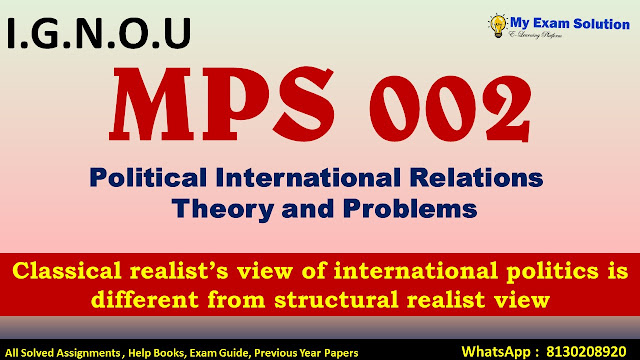The core assumptions of realist theory of diplomacy . Explain how classical realist’s view of international politics is different from structural realist view.
Classical realist’s view of international politics is
different from structural realist view Realism has dominated the tutorial study
of diplomacy since the top of war II. Realists claim to supply both the
foremost accurate explanation of state behaviour and a group of policy
prescriptions (notably the balance of power between states) for ameliorating
the inherent destabilizing elements of world affairs . Realism (including neorealism)
focuses on abiding patterns of interaction in a world system lacking a
centralized political authority. That condition of anarchy means the logic of
international politics often differs from that of domestic politics, which is
regulated by a sovereign power. Realists are generally pessimistic about the
likelihood of radical systemic reform. Realism may be a broad tradition of
thought that comprises a spread of various strands, the foremost distinctive of
which are classical realism and neorealism.
Classical Realist
Realists frequently claim to draw on an ancient tradition of
political thought. Among classic authors often cited by realists are
Thucydides, Machiavelli , Hobbes , Rousseau , and Max Weber. Realism as a
self-conscious movement within the study of diplomacy emerged during the
mid-20th century and was inspired by British social scientist and historian
E.H. Carr. Carr attacked what he perceived because the dangerous and deluded
“idealism” of liberal internationalists and, especially , their belief within
the possibility of progress through the development of international
institutions, like the League of countries . He focused instead on the
perennial role of power and self-interest in determining state behaviour. The
outbreak of war II converted many scholars thereto pessimistic vision.
Thereafter, realism became established in American politics departments, its
fortunes boosted by variety of émigré European scholars, most notably the
German-born social scientist and historian Hans Morgenthau. it's the realism of
Carr, Morgenthau, and their followers that's labeled classical.
Classical realism wasn't a coherent school of thought. It drew from a good sort of sources
and offered competing visions of the self, the state, and therefore the world. Whereas
Carr was influenced by Marxism, Morgenthau drew on Friedrich Nietzsche, Weber,
Carl Schmitt, and American civic republicanism. Classical realists were united
mainly by that which they opposed. Critical of the optimism and explanatory
ambition of liberal internationalists, classical realists instead stressed the
varied barriers to progress and reform that allegedly inhered in attribute , in
political institutions, or within the structure of the Systeme International
d'Unites . The fortunes of classical realism, grounded because it was during a
combination of history, philosophy, and theology, waned during the age of
social-scientific behaviourism within the 1960s. Its fortunes were revived by
the emergence of neorealism during the 1970s in the Classical realist’s view of
international politics is different from structural realist view.
Structural realism is taken into account by many realists and
antirealists alike because the most defensible sort of scientific realism.
There are now many sorts of structural realism and an in depth literature about
them. There are interesting connections with debates in metaphysics, philosophy
of physics and philosophy of mathematics. This entry is meant to be a
comprehensive survey of the sector .
Scientific realism is that the view that we need to believe
the unobservable entities posited by our most successful scientific theories. Classical
realist’s view of international politics is different from structural realist
view it's widely held that the foremost powerful argument in favour of
scientific realism is that the no-miracles argument, consistent with which the
success of science would be miraculous if scientific theories weren't a minimum
of approximately true descriptions of the planet . While the underdetermination
argument is usually cited as giving grounds for scepticism about theories of
unobservable entities, arguably the foremost powerful arguments against
scientific realism are supported the history of radical theory change in
science. The best-known of those arguments, although not necessarily the
foremost compelling of them, is that the notorious pessimistic meta-induction,
consistent with which reflection on the abandonment of theories within the
history of science motivates the expectation that our greatest current
scientific theories will themselves be abandoned, and hence that we ought to
not assent to them.
Structural realism was introduced into contemporary
philosophy of science by John Worrall in 1989 as how to interrupt the impasse
that results from taking both arguments seriously, and have “the better of both
worlds” within the debate about scientific realism.







0 comments:
Note: Only a member of this blog may post a comment.